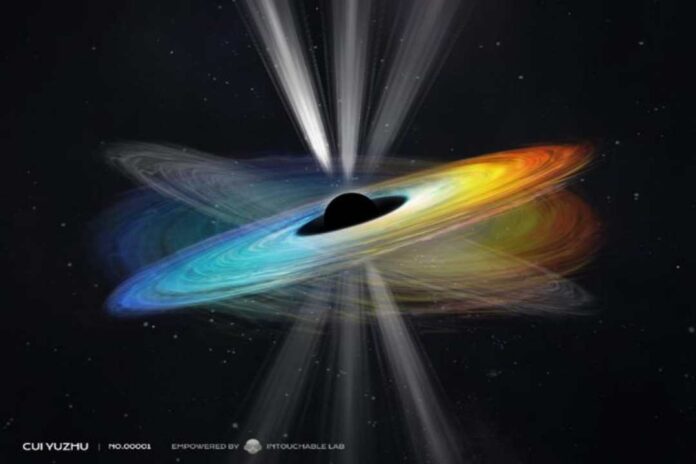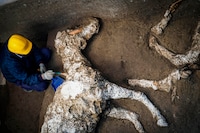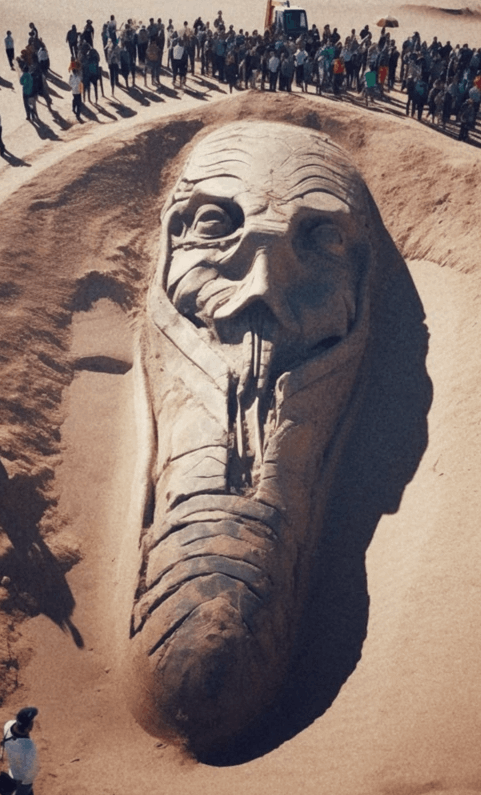
The nearby radio galaxy M87, located 55 million light-years from the Earth and harboring a black hole 6.5 billion times more mᴀssive than the Sun, exhibits an oscillating jet that swings up and down with an amplitude of about 10 degrees, confirming the black hole’s spin.
The study, which was headed by Chinese researcher Dr. CUI Yuzhu and published in Nature on Sept. 27, was conducted by an international team using a global network of radio telescopes.
Through extensive analysis of telescope data from 2000–2022, the research team revealed a recurring 11-year cycle in the precessional motion of the jet base, as predicted by Einstein’s General Theory of Relativity. The study links the dynamics of the jet with the central supermᴀssive black hole, offering evidence that M87’s black hole spins.
Supermᴀssive black holes at the center of active galaxies—the most disruptive celestial objects in our universe—can accrete tremendous amounts of material due to the extraordinary gravitational force and power of plasma outflows, known as jets, that approach the speed of light and extend thousands of light-years away.
The energy transfer mechanism among supermᴀssive black holes and their accretion disks and relativistic jets has puzzled physicists and astronomers for over a century. A prevailing theory suggests that energy can be extracted from a spinning black hole, allowing some material surrounding the supermᴀssive black hole to be ejected with great energy. However, the spin of supermᴀssive black holes, a crucial factor in this process and the most fundamental parameter other than black hole mᴀss, had not been directly observed.
In this study, the research team focused on M87, where the first observational astrophysical jet was observed in 1918. Thanks to its proximity, the jet formation regions close to the black hole can be resolved in detail with Very Long Baseline Interferometry (VLBI), as represented by recent black hole shadow imaging with the Event Horizon Telescope (EHT). By analyzing VLBI data from M87 obtained over the last 23 years, the team detected the periodic precessional jet at its base, offering insight into the status of the central black hole.
At the heart of this discovery lies the critical question: What force in the universe can alter the direction of such a powerful jet? The answer could be hidden in the behavior of the accretion disk, a configuration related to the central supermᴀssive black hole. As infalling materials orbit the black hole due to their angular momenta, they form a disk-like structure before gradually spiraling inwards until they are fatefully drawn into the black hole. However, if the black hole is spinning, it exerts a significant impact on surrounding spacetime, causing nearby objects to be dragged along its axis of rotation, a phenomenon known as “frame-dragging,” which was predicted by Einstein’s General Theory of Relativity.
The research team’s extensive analysis indicates that the rotational axis of the accretion disk misaligns with the black hole’s spin axis, leading to a precessional jet. Detecting this precession provides unequivocal evidence that the supermᴀssive black hole in M87 is indeed spinning, thus enhancing our understanding of the nature of supermᴀssive black holes.
“We are thrilled by this significant finding,” said CUI Yuzhu, a postdoctoral researcher at Zhejiang Lab, a research insтιтution in Hangzhou, and lead and corresponding author of the paper. “Since the misalignment between the black hole and the disk is relatively small and the precession period is around 11 years, accumulating high-resolution data tracing M87’s structure over two decades and thorough analysis are essential to obtain this achievement.”
“After the success of black hole imaging in this galaxy with the EHT, whether this black hole is spinning or not has been a central concern among scientists,” added Dr. Kazuhiro Hada from the National Astronomical Observatory of Japan. “Now anticipation has turned into certainty. This monster black hole is indeed spinning.”
This work made use of a total of 170 epochs of observations obtained by the East Asian VLBI Network (EAVN), the Very Long Baseline Array (VLBA), the joint array of KVN and VERA (KaVA), and the East Asia to Italy Nearly Global (EATING) network. In total, more than 20 telescopes across the globe contributed to this study.
Radio telescopes in China also made contribution to this project, including China’s Tianma 65-meter radio telescope with its huge dish and high sensitivity at millimeter wavelengths. In addition, Xinjiang 26-meter radio telescope enhances the angular resolution of EAVN observations. The good quality data with both high sensitivity and high angular resolution are essential to obtain this achievement.
“The in-building Shigatse 40-meter radio telescope by Shanghai Astronomical Observatory, will further improve the imaging capability of EAVN at millimeters. Especially, the Tibetan Plateau, where the telescope is located, owns one of the most excellent site conditions for (sub-)millimeter wavelength observations. It fulfills our expectations to promote domestic sub-millimeter facilities for astronomical observations,” said Prof. SHEN Zhiqiang, Director of the Shanghai Astronomical Observatory of the Chinese Academy of Sciences.
While this study sheds light on the mysterious world of supermᴀssive black holes, it also presents formidable challenges. The accretion disk’s structure and the exact value of the M87 supermᴀssive black hole’s spin are still highly uncertain. This work also predicts that there will be more sources with this configuration, thus challenging scientists to discover them.





